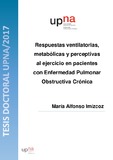Mostrar el registro sencillo del ítem
Respuestas ventilatorias, metabólicas y perceptivas al ejercicio en pacientes con enfermedad pulmonar obstructiva crónica
| dc.contributor.advisor | Gáldiz Iturri, Juan Bautista | es_ES |
| dc.contributor.advisor | Cebollero Rivas, Pilar | es_ES |
| dc.creator | Alfonso Imízcoz, María | es_ES |
| dc.date.accessioned | 2018-03-05T16:36:46Z | |
| dc.date.available | 2018-03-05T16:36:46Z | |
| dc.date.issued | 2017 | |
| dc.date.submitted | 2018-02-09 | |
| dc.identifier.uri | https://hdl.handle.net/2454/27631 | |
| dc.description.abstract | Los pacientes con EPOC presentan una limitación al ejercicio principalmente debido a una disfunción ventilatoria, anormalidades en el intercambio gaseoso y por una disfunción muscular (tanto de los músculos respiratorios como periféricos). Las Pruebas de Esfuerzo Cardiopulmonar (PECP) son herramientas imprescindibles para la valoración de los sistemas implicados en el ejercicio, y en el caso del EPOC permiten un análisis integrado de la respuesta al esfuerzo. Objetivo: evaluar si las respuestas encontradas durante la realización de las pruebas de esfuerzo mediante pedaleo o caminar en pacientes con EPOC son diferentes. Analizar el desarrollo de atrapamiento aéreo y el cambio en la fuerza y en la fatiga muscular tras realizar distintos tipos de ejercicio. Material y Métodos: se han incluido pacientes con EPOC en grado moderado-severo, a los que se les ha realizado, una PECP en cicloergómetro, en tapiz rodante y un test de marcha de seis minutos. Se ha analizado previamente y al finalizar cada prueba: el grado de atrapamiento aéreo, mediante el cálculo de la capacidad inspiratoria; la fuerza muscular, mediante dinamometría y la fatiga muscular por técnica de twitch. Además, se han valorado las respuestas perceptivas a lo largo de cada prueba. Resultados: tras la realización de la PECP en tapiz, se observa un mayor desarrollo de atrapamiento aéreo y menor fatiga muscular que en el cicloergómetro. A nivel perceptual, los pacientes presentan mayor grado de disnea al finalizar la prueba en tapiz, mientras en el cicloergómetro, la limitación es por dolor en miembros inferiores. En el test de marcha se observan una respuesta fisiológica y perceptual similar que las encontradas en el tapiz, pero con menor intensidad (menor grado de disnea al finalizar la prueba y menor desarrollo de atrapamiento aéreo). Conclusiones: las respuestas perceptivas y fisiológicas en las PECP son diferentes en función del método empleado. La limitación en las PECP en pacientes con EPOC es específica del método con el que se realiza. La disnea a lo largo del esfuerzo en pacientes con EPOC es multifactorial y no sólo se puede explicar por el atrapamiento aéreo que se desarrolla durante el ejercicio de caminar. | es_ES |
| dc.description.abstract | Patients with COPD present a limitation to exercise mainly due to ventilatory dysfunction, abnormalities in gas exchange and muscle dysfunction (in respiratory and peripheral muscles). The Cardiopulmonary Exercise Tests (CPET) are essential tools for the assessment of the systems involved in the exercise, and in the case of COPD allows an integrated analysis of the response to the effort. Objective: to evaluate if the answers found during the performance of the exercise tests by cycling or walking in patients with COPD are different. Analyze the development of air trapping and the change in strength and muscle fatigue after performing different types of exercise. Material and Methods: patients with moderate to severe COPD have been included. The patients have done, in different stages of time, a CPET on a cycle ergometer, on a treadmill and a six-minute walking test. It has been previously analyzed and at the end of each test: the degree of air trapping, by calculating the inspiratory capacity; muscle strength, by dynamometry and muscle fatigue by twitch technique. In addition, the perceptual responses have been assessed throughout each test (Borg scale). Results: after performing the CPET on the treadmill, a greater development of air trapping and less muscle fatigue was observed than in the cycle ergometer. At the perceptual level, patients present a higher degree of dyspnea at the end of the treadmill test, while in the cycle ergometer, the limitation is due to lower limb pain. In the walking test a physiological and perceptual response similar to those found in the treadmill is observed, since they share the same type of exercise that is walking, but with less intensity (less degree of dyspnea at the end of the test and less development of dynamic hyperinsuflation). Conclusions: the perceptive and physiological responses in PECP are different depending on the method used. The limitation in PECP in patients with COPD is specific to the method with which it is performed. The dyspnea along the effort in patients with COPD is multifactorial and not only can be explained by the air trapping that develops during the exercise of walking. | es_ES |
| dc.format.extent | 196 p. | es_ES |
| dc.format.mimetype | application/pdf | en |
| dc.language.iso | spa | en |
| dc.relation.uri | https://biblioteca.unavarra.es/abnetopac/abnetcl.cgi?TITN=491880 | |
| dc.subject | Enfermedad Pulmonar Obstructiva Crónica | es_ES |
| dc.subject | Pruebas de Esfuerzo Cardiopulmonar (PECP) | es_ES |
| dc.subject | Cardiopulmonary Exercise Tests (CPET) | es_ES |
| dc.title | Respuestas ventilatorias, metabólicas y perceptivas al ejercicio en pacientes con enfermedad pulmonar obstructiva crónica | es_ES |
| dc.type | Tesis doctoral / Doktoretza tesia | es |
| dc.type | info:eu-repo/semantics/doctoralThesis | en |
| dc.contributor.department | Ciencias de la Salud | es_ES |
| dc.contributor.department | Osasun Zientziak | eu |
| dc.rights.accessRights | Acceso abierto / Sarbide irekia | es |
| dc.rights.accessRights | info:eu-repo/semantics/openAccess | en |
| dc.description.doctorateProgram | Programa de Doctorado en Ciencias de la Salud (RD 99/2011) | es_ES |
| dc.description.doctorateProgram | Osasun Zientzietako Doktoretza Programa (ED 99/2011) | eu |


